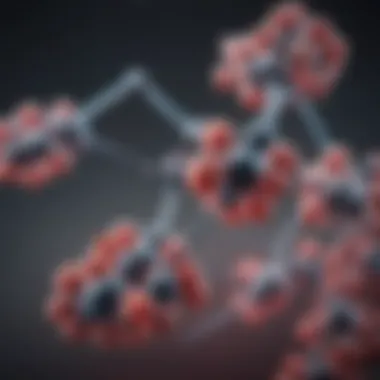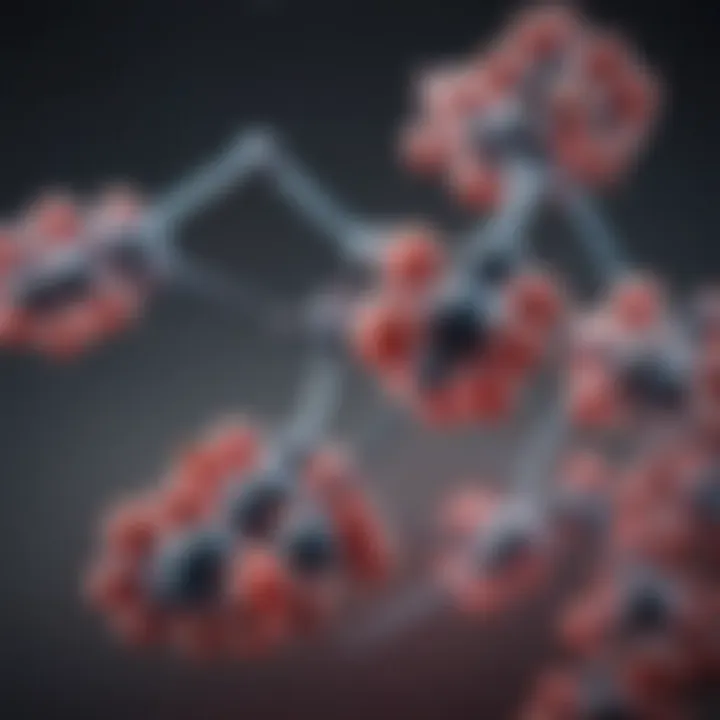Neurontin for Seizures: An In-Depth Review


Research Context
Background and Rationale
Gabapentin, commonly recognized by the brand name Neurontin, is frequently utilized in the management of various neurological disorders. Originally developed to treat epilepsy, it has gained popularity due to its efficacy in treating neuropathic pain and other conditions. Understanding the role of Neurontin in seizure management is critical as it offers an alternative for patients who may not respond well to traditional antiepileptic drugs. The growing prevalence of epilepsy and its associated disorders creates an urgent need for new treatment modalities. Hence, an in-depth examination of Neurontin’s pharmacological properties, its interactions, and its clinical outcomes is warranted.
Literature Review
A substantial body of research exists regarding gabapentin's effectiveness for seizure control. Studies have demonstrated that Neurontin can serve as an adjunct therapy in refractory epilepsy cases. Clinical trials underscore its ability to reduce seizure frequency and improve quality of life for patients suffering from partial seizures. Comparisons with established antiepileptic medications illustrate that while Neurontin may not be the first-line treatment, it is beneficial for specific patient populations.
"Gabapentin, while not universally effective, provides significant advantages in certain contexts, particularly for epileptic patients resistant to conventional therapies."
Furthermore, reviews in prominent medical journals stress the importance of tailoring epilepsy treatment to individual patients. Factors such as patient history, concurrent medications, and potential side effects must be considered before prescribing Neurontin. This literature outlines not only the benefits but also highlights potential risks, allowing for a more comprehensive understanding of its role in seizure management.
Methodology
Research Design
The methodology for gauging Neurontin's effectiveness in treating seizures often explores randomized controlled trials and observational studies. By applying rigorous scientific methods, researchers can assess the drug's impact on various demographics, including age, gender, and seizure type. This systematic approach ensures results are reliable and clinically relevant.
Data Collection Methods
Data collection in studies focusing on Neurontin typically involves collecting clinical data from patient records, surveys, and clinical assessments. Work conducted through both quantitative and qualitative means enriches the understanding of how Neurontin impacts seizure activity. Through measures such as seizure frequency diary entries and quality of life assessments, clinicians can gather comprehensive insights that inform treatment plans.
Integrating these findings into the wider context of anticonvulsant therapy reveals the multifaceted nature of managing seizures. As our understanding of neorological drugs evolves, so too does the imperative to critically evaluate older medications like Neurontin in light of contemporary data.
Foreword
The topic of seizure disorders is of great importance, both in medicine and in the lives of those affected by such conditions. Seizures can disrupt daily functioning and impact the overall quality of life. The management of these disorders requires a thorough understanding of various treatment options. One such option is Neurontin, also known as gabapentin. This article delves into its characteristics, efficacy, and role in treating seizures.
When discussing epilepsy and other seizure disorders, it is crucial to explore a range of treatment modalities. Neurontin has gained attention as a potential solution, especially for patients who might not respond well to traditional antiepileptic drugs. Understanding its pharmacological properties, clinical implications, and the necessary guidelines for its use is essential in providing informed healthcare decisions.
Overview of Seizure Disorders
Seizure disorders encompass a variety of conditions defined by recurring seizures. These can range from focal seizures affecting a limited part of the brain to generalized seizures that involve the entire brain. Understanding the different types of seizure disorders is important for proper diagnosis and treatment.
Common causes of seizures include genetic factors, brain injuries, infections, and metabolic disturbances. Each seizure type can have different manifestations, which can complicate diagnosis and treatment.
Effective management is vital, as untreated seizures can lead to other health issues, injuries, and further complications.
Prelims to Neurontin
Neurontin, or gabapentin, was originally developed for treating epilepsy, but has evolved in its applications over the years. This medication acts on the nervous system to help stabilize neuronal activity. The understanding of Neurontin's mechanisms also highlights its potential benefits for patients with neuropathic pain and other conditions.
As a pivotal alternative in seizure management, Neurontin presents unique advantages and challenges. Its increasing use warrants a detailed review of its efficacy, potential side effects, and overall role in current seizure treatment protocols.
In this article, we commit to analyzing these aspects while providing a comprehensive guide to Neurontin’s position in the therapeutic landscape.
Mechanism of Action
Understanding the mechanism of action of Neurontin, or gabapentin, is vital in appreciating its therapeutic role in seizure management. The way a drug works informs clinicians about its potential effectiveness, safety, and use in different patient populations. Gabapentin's specific pharmacological properties help delineate its place within the wider context of antiepileptic therapies. Thus, a thorough exploration of its mechanism could offer clearer insights into how and why this medication provides benefits in alleviating seizure disorders.
Pharmacodynamics of Gabapentin
Gabapentin's pharmacodynamic profile highlights its interaction with the voltage-gated calcium channels in the neurons. It primarily targets the alpha-2-delta subunit of these channels, which plays a critical role in synaptic transmission. By inhibiting the influx of calcium, gabapentin effectively reduces the release of excitatory neurotransmitters, thereby stabilizing neuronal excitability. This action is fundamental in preventing the excessive electrical activity that characterizes seizures.
Additionally, gabapentin displays unique properties that differentiate it from other antiepileptic drugs. Unlike many traditional medications that primarily focus on GABAergic systems, gabapentin’s mechanism does not rely on enhancing GABA activity. Therefore, it stands as a complementary option in managing seizures. Furthermore, its efficacy may extend beyond seizure control, impacting concomitant conditions such as neuropathic pain, underscoring its versatility as a treatment.
Neuronal Modulation
The modulation of neuronal activity is a core component of gabapentin's therapeutic effects. This modulation occurs through a combination of inhibiting excitatory signals and enhancing inhibitory ones. Gabapentin’s action leads to decreased glutamate release, which contributes to its anticonvulsant effects. Such dynamics create a more stable neural environment, which is especially crucial for individuals experiencing recurrent seizures.
The brain's electrical activity can be delicate, with many factors contributing to potential seizures. Gabapentin’s unique properties make it an effective option in maintaining a more controlled environment within the central nervous system. Practitioners must consider these attributes when prescribing gabapentin, as it may offer improved outcomes for patients who are unresponsive to other medications.
By providing more targeted modulation of neuronal activity, gabapentin enhances therapeutic approaches in seizure management. Its emphasis on calcium channel blockade, contrasted with traditional agents, positions it as a valuable asset in both monotherapy and adjunctive therapy.
Clinical Efficacy


The clinical efficacy of Neurontin, or gabapentin, is a central component of its application in seizure management. Understanding how effective this medication is in treating seizure disorders helps healthcare providers make informed decisions about treatment plans. Efficacy refers not only to how well the drug works in a clinical setting but also considers aspects like patient response, dosing strategies, and overall quality of life improvements.
Evidence from Clinical Trials
Numerous clinical trials have evaluated the efficacy of Neurontin in the treatment of various seizure types. One significant study demonstrated that gabapentin significantly reduced seizure frequency in patients with partial seizures when used as an adjunctive therapy. This finding is critical as it provides clinical evidence supporting its use beyond monotherapy.
- Key Points in Trials:
- Most trials measured outcomes based on the percentage reduction in seizure frequency.
- Patients in trials often reported not only fewer seizures but also an improvement in overall well-being.
- The tolerability profile of gabapentin in these studies further contributed to its positive evaluation in treating conditions like epilepsy.
"Gabapentin provides a promising option for patients who have not responded well to other antiepileptic drugs."
However, the variability of individual responses raises considerations for personalized treatment plans. It is essential for clinicians to monitor patient outcomes closely to adjust dosages as needed to achieve optimal results.
Comparison with Traditional Antiepileptic Drugs
When compared to traditional antiepileptic drugs, the clinical efficacy of Neurontin reveals both advantages and limitations. Traditional agents such as phenytoin and carbamazepine have long history in managing seizures but can come with significant side effects. Neurontin, on the other hand, is often noted for its favorable tolerability profile. This offers an appealing alternative for patients who may not tolerate other medications well.
- Efficacy Attributes:
- Gabapentin may be used effectively as an adjunct treatment, showcasing complementary action alongside other therapies.
- In patients resistant to conventional drugs, Neurontin can help reduce seizures, which may contribute to improved daily functioning.
- Patients often select gabapentin for its less severe side effects, making it suitable for long-term management.
Despite these benefits, Neurontin may not be as effective for all types of seizures, particularly generalized seizures. In such cases, other medication options may provide superior efficacy. It is crucial for healthcare providers to weigh the strengths and weaknesses of gabapentin against traditional drugs based on the patient’s seizure profile and overall health.
In summary, the clinical efficacy of Neurontin is supported by a growing body of evidence but must always be contextualized within the broader spectrum of available treatments.
Dosage and Administration
Understanding the dosage and administration of Neurontin, or gabapentin, is crucial in ensuring effective seizure management. Proper dosing directly influences both the efficacy and safety of the treatment. Inadequate or excessive dosages can lead to suboptimal results or adverse effects, making it essential for healthcare providers to adhere to established guidelines. Administering gabapentin correctly enhances patient outcomes and fosters better compliance among those undergoing treatment for seizure disorders.
Recommended Dosage Guidelines
The dosing of Neurontin for seizures varies depending on the patient's age, kidney function, and the specific type of seizure disorder being treated. Typical starting doses may range from 300 mg to 900 mg per day, divided into multiple doses. Here are some key points regarding the recommended dosage:
- Initial Dosing: For adults and children over 12 years, a common starting dose is 300 mg on the first day, followed by an increase to 600 mg by the third day, and then further adjustments can be made based on tolerance and therapeutic response.
- Maintenance Dosing: Generally, patients may be maintained on doses ranging from 900 mg to 1800 mg per day, depending on the individual's needs. Individual titration can optimize the dose based on the patient’s therapeutic response.
- Pediatric Dosing: For children aged 3 to 12 years, the dosing is often based on weight, typically starting at 10 mg/kg per day.
- Elderly Patients: Special considerations must be made for older adults, who may require lower doses. Renal function must also be evaluated since dosage adjustments may be necessary to avoid toxicity.
Administration Considerations
Administration of Neurontin involves certain considerations to maximize its effectiveness. How and when it is taken can significantly alter the drug’s impact on seizure control. Here are several important aspects to consider:
- Route of Administration: Neurontin is taken orally, and it can be consumed with or without food. However, consistent dietary habits may help reduce gastrointestinal side effects.
- Splitting Doses: Gabapentin has a relatively short half-life, necessitating divided doses throughout the day. The total daily dose should be divided into three doses taken at consistent intervals to maintain stable drug levels in the bloodstream.
- Missed Doses: If a dose is missed, it should be taken as soon as the patient remembers. However, if it is nearly time for the next dose, the missed dose should be skipped. Doubling up on doses is not advised.
- Adjustments for Renal Impairment: For patients with renal impairment, the dosing regimen must be adjusted according to creatinine clearance levels. Regular monitoring is crucial to avoid potential toxicity.
In summary, dosing and administration of Neurontin are foundational elements in the management of seizures. Adhering to the recommended guidelines and considering individual patient needs can significantly impact treatment outcomes.
Side Effects and Risks
The examination of side effects and risks associated with Neurontin is a key component of understanding its overall impact in seizure management. Patients and healthcare providers must carefully navigate the potential downsides of any medication. This section highlights these important considerations, as they can influence treatment adherence and patient outcomes.
Common Side Effects
Neurontin, or gabapentin, is generally well-tolerated; however, it is not without risks. Common side effects typically occur in patients, especially during the initiation of treatment. Some frequent side effects include:
- Drowsiness: Many patients experience sedation, which can affect daily activities and alertness.
- Dizziness: This can occur frequently and may lead to falls, especially in elderly patients.
- Fatigue: A sense of tiredness has been reported, which can be debilitating over time.
- Nausea and Vomiting: Though less common, these gastrointestinal symptoms can deter some patients from continuing the medication.
- Peripheral Edema: Swelling in the limbs can develop, which may raise concerns about fluid retention and overall health.
It is essential for patients to communicate any adverse effects they experience to their healthcare providers. Timely management of side effects can enhance treatment adherence and overall satisfaction with therapy.
Serious Risks and Complications
In addition to common side effects, Neurontin carries some serious risks that require vigilant monitoring. While such events are rarer, they can lead to critical health issues. Notable serious risks include:
- Suicidal Thoughts: There is an increased risk of suicidal ideation and behavior in some patients, necessitating monitoring of mood changes and mental health status.
- Severe Allergic Reactions: Though infrequent, some individuals may experience notable hypersensitivity, leading to symptoms such as rash, itching, and even anaphylaxis.
- Respiratory Depression: This is especially concerning when gabapentin is combined with other central nervous system depressants.
- Withdrawal Symptoms: Abrupt discontinuation of Neurontin may lead to withdrawal symptoms, such as anxiety, insomnia, and seizures, necessitating a gradual taper.
"Always consult a healthcare professional if experiencing unexpected or severe symptoms while on Neurontin. Patient safety is paramount."
In summary, while Neurontin displays clinical efficacy in managing seizures, its side effects and potential serious risks cannot be overlooked. Understanding these factors is critical for both patients and healthcare providers to ensure optimal treatment outcomes and safety.
Drug Interactions


Understanding drug interactions is crucial when considering Neurontin (gabapentin) for seizure management. Interactions can affect the efficacy of gabapentin and the overall treatment outcome. Recognizing these interactions helps clinicians make informed decisions, ensuring safety and optimizing therapy for patients with seizure disorders.
Pharmacokinetic Interactions
Gabapentin has unique pharmacokinetic properties that can be influenced by other medications. This can affect absorption, distribution, metabolism, and elimination of drugs in the body.
- Absorption: Gabapentin's absorption is not significantly altered by food, but certain medications may affect gastric pH or gastrointestinal motility, possibly impacting its bioavailability.
- Active transport: Gabapentin employs the neutral amino acid transport system for absorption. Drugs that manipulate these transporters might influence gabapentin levels in the bloodstream.
- Renal excretion: Gabapentin is primarily cleared by the kidneys. Concomitant medications that affect renal function can increase or decrease gabapentin levels, leading to possible toxicity or therapeutic inadequacy.
Overall, awareness of these interactions allows for careful management of gabapentin in polypharmacy scenarios.
Clinical Implications of Interactions
The clinical implications of drug interactions with Neurontin are significant. They can lead to adverse effects or reduced efficacy, particularly in patients taking multiple medications.
- Increased sedative effects: When gabapentin is combined with other central nervous system depressants like opioids or benzodiazepines, there is a heightened risk of sedation, respiratory depression, or even overdose.
- Antiepileptic drug synergy: Some patients may be on other antiepileptic drugs (AEDs). The pharmacodynamic interactions between gabapentin and other AEDs can enhance seizure control or, conversely, could lead to increased side effects.
- Monitoring requirements: Clinicians must monitor patients closely for any unusual side effects or reduced seizure control. Adjustment of the gabapentin dose or the timing of administration may be necessary to mitigate these risks.
"A thorough assessment of potential drug interactions is essential in achieving optimal outcomes in patients receiving gabapentin for seizure management."
Patient Population Considerations
Understanding the nuances of patient population considerations is critical in the context of Neurontin usage in seizure management. Each demographic group exhibits distinct characteristics, responses to medications, and potential risks. Tailoring treatment approaches according to these specific elements enhances the overall efficacy of therapy and minimizes complications. This section will delve into considerations for elderly patients, pediatric patients, and those with renal impairment, providing a strategic insight that informs clinical decision-making.
Elderly Patients
Elderly patients often present unique challenges in the management of seizure disorders. Age-related physiological changes can significantly impact drug metabolism and elimination. For example, the liver and renal functions typically decline with age, which may prolong the half-life of Neurontin. Consequently, dosing must be adjusted to avoid the risk of toxicity.
Additionally, elderly individuals are more likely to experience polypharmacy, where multiple medications are prescribed. This raises concerns about potential drug interactions that could complicate seizure management. It is vital for healthcare providers to carefully review a patient’s entire medication list. Moreover, the potential for cognitive impairment or decline in functional status among elderly patients necessitates a thorough evaluation of both the benefits and risks associated with Neurontin. Regular monitoring is crucial to ensure patient safety and optimize therapeutic outcomes.
Pediatric Patients
Pediatric patients represent another specific population that requires careful consideration when prescribing Neurontin for seizure control. Children may metabolize drugs differently than adults, leading to variations in efficacy and tolerability. The dosing of Neurontin in children is generally weight-based, hence reliance on accurate weight measurement is essential.
Moreover, the safety profile of Neurontin in younger populations is an area of ongoing research. Various studies have reported differing rates of adverse effects, making it essential for healthcare providers to stay updated on the latest findings. Monitoring for behavioral changes is also important, as children may not communicate side effects as effectively as adults. Practitioners must consider both short-term and long-term implications of therapy in this population. Family involvement plays a key role in ensuring adherence, thereby maximizing treatment benefits.
Patients with Renal Impairment
Renal impairment can profoundly influence the pharmacokinetics of Neurontin. The drug is primarily eliminated through the kidneys, making dose adjustments essential for patients with reduced renal function. Ignoring these adjustments can lead to an accumulation of gabapentin in the body, increasing the risk of serious side effects such as sedation and dizziness.
In practice, screening renal function through creatinine clearance calculations becomes a vital step before initiating therapy. Depending on the severity of the renal dysfunction, prescribers may need to reduce the starting dose or enhance the dosing interval to maintain therapeutic levels while minimizing risks. Clinical guidelines suggest close monitoring of renal function throughout treatment, ensuring that adjustments are made as necessary.
Historical Context
Understanding the historical context of Neurontin, or gabapentin, is essential for grasping its significance in managing seizure disorders. The development of gabapentin marked a turning point in the pharmacological approach to epilepsy. It is crucial to appreciate the timeline of its creation and the shifts in treatment strategies that preceded and followed its introduction.
Development of Gabapentin
Gabapentin was developed in the late 1970s by scientists at Parke-Davis Laboratories. The initial goal was to create a medication that could effectively address neuropathic pain. However, during clinical trials, researchers discovered its anticonvulsant properties. In 1993, the U.S. Food and Drug Administration approved gabapentin for the treatment of partial seizures in adults. This approval was ground-breaking since it was one of the first new classes of antiepileptic drugs introduced in many years.
Gabapentin's chemical structure is similar to that of gamma-aminobutyric acid (GABA), a neurotransmitter that inhibits nerve activity. While gabapentin does not bind directly to GABA receptors, it does influence the activity of certain calcium channels in the brain, contributing to its anticonvulsant effects. These mechanisms of action initially sparked interest in gabapentin as a viable option for seizure management,
for those patients who did not respond well to traditional therapies.
Evolution in Seizure Treatment Protocols
The evolution of treatment protocols for seizures alongside the introduction of gabapentin reveals a change in the medical community's approach. In the earlier decades, treatment options were limited primarily to barbiturates and benzodiazepines, which often came with significant side effects and limitations.
With the approval of gabapentin, practitioners began to search for more varied and effective treatment regimens. This led to a broader consideration of polytherapy—a strategy that involves using multiple medications to control seizures when monotherapy is ineffective. Gabapentin's unique profile allowed it to be used safely alongside other antiepileptics, facilitating combinations that addressed individual patient needs more effectively.
As knowledge of seizure disorders expanded, gabapentin found applications beyond epilepsy. Its effectiveness in treating neuropathic pain led to its off-label use for conditions like fibromyalgia and restless leg syndrome. Over the years, researchers have continued to investigate gabapentin through various studies, enhancing its profile as a multifaceted therapeutic agent.
"Gabapentin's introduction illustrated a paradigm shift in how physicians approach seizure management, emphasizing a more personalized and comprehensive care model."
Thus, the historical backdrop of gabapentin speaks to the ongoing journey of medical advancements in treating epilepsy. Understanding this context not only informs current practices but also sets the stage for exploring innovative treatment strategies in the future. This foundation remains invaluable for students, researchers, educators, and professionals attempting to navigate the complexities of managing seizure disorders and denotes an evolution that continues to influence therapeutic approaches.
Alternative Treatments for Seizures
The management of seizure disorders goes beyond the traditional pharmacological approaches. In the search for efficacious treatment options, exploring alternative treatments becomes vital. The term "alternative treatments" refers to the various methods, aside from primary antiepileptic drugs, that may offer therapeutic benefits. These approaches can include other antiepileptic medications, as well as non-pharmacological interventions.


Understanding the landscape of alternative treatments is important for creating personalized treatment plans. Not every patient responds the same way to conventional medications. Factors such as age, type of epilepsy, and individual side effect profiles necessitate a broader approach to treatment. Alternative treatments can provide patients with options that may lead to better control of seizures or fewer side effects.
Other Antiepileptic Drugs
There are several other antiepileptic drugs available that can be considered as alternatives to Neurontin. Each medication comes with its unique profile, benefits, and potential drawbacks. Examples include:
- Lamotrigine: Often used for partial seizures and generalized seizures, it is known for its favorable side effect profile.
- Levetiracetam: This medication can be effective for various seizure types, and it has minimal drug interactions.
- Topiramate: Known for its efficacy in controlling seizures, it also has weight-loss effects but may cause cognitive difficulties in some individuals.
These drugs can serve as monotherapy or adjunctive therapy with Neurontin, depending on a patient’s specific needs. Physicians often consider factors like effective dosage, patient's history with medication, and specific seizure types when suggesting alternative antiepileptic drugs.
Non-Pharmacological Interventions
Beyond medication, non-pharmacological interventions are emerging as valuable treatment options for seizure management. These methods can enhance quality of life and reduce reliance on drugs. Some notable non-pharmacological approaches include:
- Dietary Modifications: The ketogenic diet has shown success in reducing seizure frequency in some patients, particularly those with refractory epilepsy.
- Vagus Nerve Stimulation (VNS): This surgical intervention involves implanting a device that stimulates the vagus nerve, shown to help reduce seizures in certain populations.
- Cognitive Behavioral Therapy (CBT): Although primarily aimed at mental health, CBT can help patients develop coping strategies for dealing with the psychosocial aspects of living with epilepsy.
Implementing these alternatives may require an interdisciplinary approach where neurologists collaborate with dietitians or psychologists. Balancing these methods with drug therapies like Neurontin may yield optimal results for many patients.
The integration of alternative treatments in the management of seizures highlights the need for personalized medicine, tailoring options based on individual patient circumstances.
In summary, the exploration of alternative treatments for seizures plays a critical role in contemporary epilepsy management. Both other antiepileptic drugs and non-pharmacological interventions present opportunities for enhanced patient care and better seizure control.
Future Directions in Seizure Management
The realm of seizure management is evolving continually. Future directions in this area stand to reshape treatment protocols for patients with seizure disorders. Gaining a comprehensive understanding of these advancements is essential for healthcare professionals, researchers, and patients alike. This section delves into emerging therapies and personalized medicine initiatives that may enhance the efficacy of treatments like Neurontin.
Research into Novel Therapies
Current research is increasingly focused on discovering novel therapies that target the underlying mechanisms of seizures. Various avenues are being explored, including the development of new pharmaceutical agents and non-pharmacological interventions. Each of these approaches has its own benefits and complexities.
- Pharmaceutical Development
- Neurostimulation Devices
- New antiepileptic drugs aim to offer improved efficacy with fewer side effects. Research is considering compounds that act on different neurotransmitter systems, such as glutamate and GABA receptors.
- Studies have also begun to assess the potential of cannabinoid therapies for seizure control. These agents are derived from cannabis and may help reduce the frequency of seizures in some patients.
- Devices such as responsive neurostimulation (RNS) and transcranial magnetic stimulation (TMS) are being evaluated for their role in seizure management. These devices can modulate brain activity and may lead to a reduction in seizure frequency.
"New therapies can provide significant advantages for patients who do not respond well to existing treatments. Understanding these options is critical for developing effective management strategies."
This focus on novel therapies offers promise. However, ongoing clinical trials and studies will need to evaluate safety and efficacy comprehensively.
Advancements in Personalized Medicine
Personalized medicine aims to tailor treatment approaches based on individual patient profiles. This paradigm shift is crucial, especially in fields like epilepsy, where patient responses to medication can vary greatly.
- Genetic Profiling
- Tailored Treatment Plans
- Monitoring and Adjustments
- Emerging techniques in genetic profiling allow for better understanding of how a patient's genetic makeup affects their response to antiepileptic drugs. For instance, identifying specific gene mutations can help clinicians determine the most effective treatment options.
- By leveraging patient data such as genetic information and seizure types, healthcare providers can create more tailored treatment plans. This can enhance the likelihood of success in seizure control.
- With advancements in technology, monitoring systems are becoming more sophisticated. Wearable devices can now provide real-time data about seizures, allowing for timely adjustments to treatment. This proactive approach may lead to better outcomes for patients.
As personalized medicine continues to grow, it engages patients in their treatment plans. This ownership often results in improved adherence and outcomes. The intersection of new therapies and personalized strategies is promising for developing effective interventions in seizure management.
Ending
The conclusion of any comprehensive review is a crucial aspect that synthesizes the entire discussion. In this article, the conclusion provides a summative overview of the key points regarding Neurontin, also known as gabapentin. This section invites readers to reflect on the multifaceted roles Neurontin plays in managing seizure disorders. It serves not only as a recap but also as a platform for understanding its potential implications in clinical practice.
Summary of Key Findings
Neurontin has emerged as a noteworthy option for individuals suffering from seizure disorders. Key findings in this article highlight the following:
- Clinical efficacy: Neurontin has demonstrated promise in various clinical trials, showcasing its ability to reduce seizure frequency in numerous patients.
- Mode of action: Understanding the pharmacodynamics of gabapentin reveals how it works on a neuronal level. It modulates certain neurotransmitters, which can significantly impact seizure control.
- Side effects and interactions: The drug can present various side effects. Although many are mild, healthcare providers must be vigilant about potential adverse reactions and drug interactions.
- Usage guidelines: Recommended dosages provide critical insight into how Neurontin should be administered for optimal effectiveness, especially in special populations, such as the elderly or those with renal impairment.
This summary encapsulates essential insights gleaned from the article, emphasizing the need for further research and clinical focus on personalized treatment approaches.
Implications for Clinical Practice
The implications of Neurontin in clinical practice are nuanced and significant. Healthcare professionals should consider the following points:
- Tailored treatment: Neurontin offers a flexible option for adjusting treatment plans based on an individual's unique seizure profile. This is particularly beneficial where traditional antiepileptic drugs have not been effective.
- Informed decision-making: Understanding the full range of side effects, as well as potential drug interactions, allows practitioners to make educated choices when prescribing Neurontin.
- Continued education: Staying informed about ongoing research will support healthcare providers in utilizing Neurontin effectively in their practices and addressing patient needs comprehensively.
Ultimately, the conclusion not only highlights the critical findings of Neurontin's effectiveness but also emphasizes the responsibility of practitioners in engaging with new evidence to support their clinical decisions. As the landscape of seizure management evolves, Neurontin remains a notable component that warrants ongoing discussion and evaluation.



